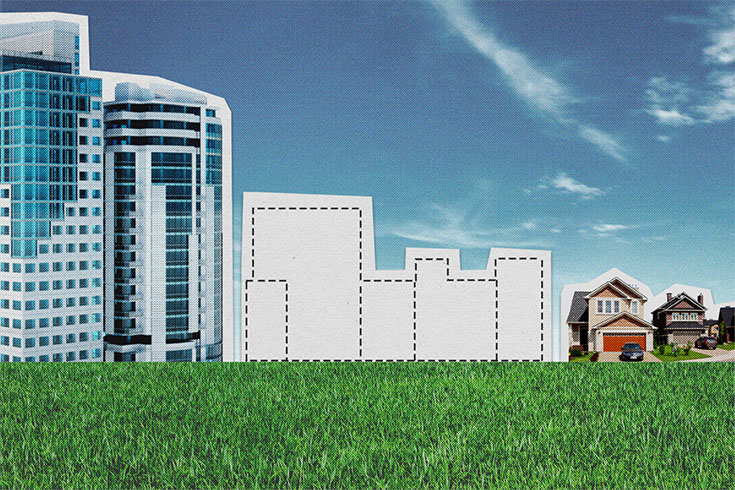Earlier this year, Victoria, British Columbia, passed what some are calling the most ambitious attempt anywhere in the country to make it easier to densify neighbourhoods: constructing so-called “missing middle” housing.
The policy, adopted in January, is intended to level the playing field for homeowners and developers who want to build denser housing—townhouses, houseplexes, duplexes—by removing the requirement to receive approval from city council, a time-consuming, politically charged, and risky step. Now all that’s needed is a permit from the city, and any single-family home can be converted into, for example, a triplex.
The legislation immediately hit snags. An urban planner and developer like Luke Mari, who owns a company that focuses on dense housing, has realized that he can’t profit from buying a house and either tearing it down or remodelling it to accommodate more units, despite the new set of bylaws designed specifically to allow that to happen. The difference between the expenses—which include buying a property, designing a new building, and demolishing or remodelling into more units—and what people are able to pay for those units is just not big enough to justify the increasing cost of borrowing money. Land and construction costs are too high, while the number of units and the allowed size of a building are too small to make a potential project work.
During the pandemic, prices for homes in Victoria have grown from unaffordable to, according to the Royal Bank of Canada, “impossible”—rising nearly a third since the end of 2019. The benchmark price for a single detached house in the city proper (as opposed to one of the slightly more affordable outlying municipalities) was approximately $1.3 million in April this year. The median household income in Victoria is $67,500, around the national average. But according to an analysis by Generation Squeeze, it would take an average young adult (twenty-five to thirty-four years old) twenty-two years to save for a down payment. Average prices, the report found, would need to fall 60 percent of the 2021 value to become affordable to an average young person.
A townhouse, meanwhile, costs around $450,000 less than a detached house. That’s the logic of the missing middle policy: by giving property owners and developers more freedom to build that cheaper housing, some level of affordability may follow. But the city of Victoria has not had a single application to build anything under the bylaws since they came into effect in March.
The bylaws, Mari says, are “incredibly restrictive, to the point where it doesn’t work at all.” It wasn’t for lack of trying. Like many cities across Canada, Victoria is in need of a solution for its twin housing problems: a lack of affordability and a lack of options. Offering the possibility of a way out of one or both, the city’s missing middle policy went through years of development and debate and was one of the most significant individual policy questions in Victoria’s October 2022 municipal election—even the Globe and Mail ’s editorial board offered strong support. Mayor Marianne Alto, who backed the policy change, trounced her opponent, fellow councillor Stephen Andrew, who had criticized it in a mayoral debate, calling it an “immature policy.” Most commonly cited by the opponents of the policy was the fact that the bylaws would remove the need for any consultation process; neighbours no longer have a say in small-scale redevelopments in their neighbourhoods, and some detractors felt there would be a tsunami of redevelopments if the policy went through. Nevertheless, shortly after the election, the legislation was voted through by a majority of council.
Victoria’s early swing at growing and diversifying its housing options has inspired other jurisdictions, including neighbouring Saanich as well as the BC provincial government itself, to develop their own similar policies. The provincial policy, yet to be introduced as legislation, would mimic Victoria’s in cities across the entire province—but won’t go as far. In Toronto, Olivia Chow was just elected mayor on a promise to bring about similar changes. Victoria is a progressive city in desperate need of housing options as it haemorrhages young families. If missing middle isn’t working here, why would it work anywhere else?
The headquarters of Mari’s company, Aryze Developments, adjoins a quaint coffee shop and a pharmacy in a leafy neighbourhood of Victoria. Upstairs is more office space and an apartment—all in a 1908 building owned by the pharmacist’s family. It’s exactly the kind of mixed-use building that seems to have disappeared from Canadian neighbourhoods—and the kind the missing middle initiative was designed, in part, to allow.
Even before the policy was passed, however, the city was tamping down expectations of a wave of new affordable construction. “Missing middle housing helps divide land costs, but it can’t fix affordability on its own,” reads a tip sheet from the city published during the consultation period. The intention behind missing middle housing was that several people effectively splitting the cost of what was formerly a single-family home would lower the cost for each buyer—three units on the same patch of land means, simplistically, each buyer only pays a third of the money for the land under a single-family home.
That theory works better when land costs aren’t already in the stratosphere. In the neighbourhood where Aryze’s mixed-use office is located, Mari says, the eye-watering prices are impossible to overcome. “It’s $400,000 per unit in land costs alone,” he says.
“Per unit” is the operative term. The number of units that can share those land costs is limited by the details of the policy. For example: under the new bylaws, the required setbacks (the empty space builders have to leave between the home and the property line) for missing middle developments are as much as four times what they are for a single-family home. That can limit the size of the building, making it more expensive per square foot. In some cases, the bylaws require the developers to pay “amenity contributions,” or money paid to the city to build anything from a skating rink to a sewer line; in some cases, they include rentals, as part of the development, in perpetuity. Those are both added costs that developers find frustrating and high, and, critically, that don’t apply to a new single-family home.
All those requirements aside, for Ryan Jabs, a small-scale developer in Victoria who specializes in this kind of housing, nothing stings as much as the requirement for parking. His aversion comes from the basic economics of building on small spaces: reserving valuable space for cars means less space available for building the actual housing. A requirement for parking can mean the difference between a project that’s economically viable and one that isn’t—and to Jabs’s dismay, the missing middle bylaws require approximately three off-street parking spots for every four units. For a developer hoping to market car-free housing with plentiful bike storage and car-share memberships, devoting hundreds of square feet of buildable space to private cars feels perverse and puts him in the position of bringing projects through that same lengthy rezoning process the missing middle bylaws were intended to avoid.
What it comes down to is that to demolish a house and rebuild another giant single-family house is still significantly easier than building a few smaller units. That may change eventually: the policy will be reviewed at set intervals, and at the start of June, council asked staff to compile all the requirements that are asked of single-family and missing middle home builders, with the aim of moving toward harmonizing them once and for all. But if the goal is to get builders building, the legislation has already been an obvious failure, and the glaring lack of applications attests to that. “The policy, as is, is unworkable,” says Victoria housing analyst Leo Spalteholz. “It is essentially dead until they make changes.”
Victoria’s battle for the missing middle has fractured the city. Op-eds and radio call-in shows were swamped with opinions on the subject for months. When it came to a public hearing, people packed into two sessions lasting more than eleven hours, as though all the individual rezoning battles the policy was intended to prevent were being fought all at once. It’s a battle that’s also being fought nationwide.
The COVID-19 pandemic brought an influx of people to the east coast of Canada. For the first time since the 1980s, more Canadians were moving to the Atlantic provinces than away from them. With each worker in need of housing, housing discussions took on a new urgency. Prices shot up.
“Maybe the term ‘missing middle’ isn’t in everybody’s lexicon,” says Ian Watson, a senior planner with the consulting firm Upland Planning and Design, but no matter where you look, people are talking about ways to add new housing options within cities rather than expanding ever outward into the sprawling suburbs. Now Halifax allows three units on every lot, but even Yarmouth, with a population of approximately 7,000, is considering its options. When Watson brought a draft plan to the town’s planning committee, he was expecting resistance to the density increases he was proposing, similar to what is typically seen when someone tries to propose denser housing anywhere: concerns about the loss of street parking, increases in noise, more wear and tear of the amenities, and a general fear for the loss of the nebulous “neighbourhood character.” Instead, he recalls, he got a different reaction: I don’t think we’re going far enough. Can we allow more?
A January 2023 report from Scotiabank noted that doubling Canada’s supply of social housing—by building, buying, renovating, and retrofitting buildings—to bring it in line with other OECD countries “could be a start.” Cities like Vienna, Austria, have famously invested huge sums in social housing that most of the population is eligible for—to fabulous effect. Of the nearly half a million residents of Vienna’s social housing buildings, no one has to pay more than a quarter of their household income for housing, compared to around one in three people in Toronto or Vancouver.
The BC government is still developing its own missing middle–style legislation. What’s been announced so far only allows up to four units to be built on a lot—even fewer than in Victoria, meaning there is even less margin for developers and banks, who are ultimately the ones to determine if something will go forward. BC housing minister Ravi Kahlon says his ministry is watching the Victoria example but has seen the lack of uptake. “I appreciate the challenges,” he says. “But we’re confident that if it’s done in a large scale across the province, that we can really see the amount of supply of housing that we need.”
Housing density will likely factor into the next federal election. Conservative Party leader Pierre Poilievre has promised to “fire gatekeepers” and increase housing supply, with carrots and sticks for municipalities based on their rate of building. The NDP’s platform has promised housing on the other end of the spectrum: 500,000 affordable units through co-ops, social housing, and non-profit housing.
There’s no sign that single-family home prices will drop to affordable levels, absent an economic meltdown, any time soon in Victoria. All governments can do is try to move the levers they have and hope for good outcomes. If nothing else, Victoria can offer a lesson: in a hotly contested election in places with severe housing shortages, voters may be willing to throw out the status quo regarding how cities are built and try something radical. What will be key is producing something radical that works.





